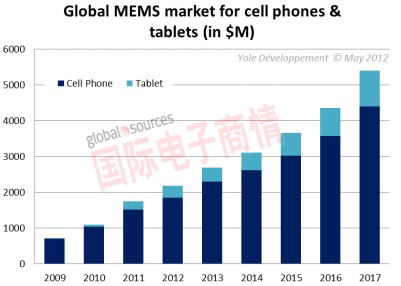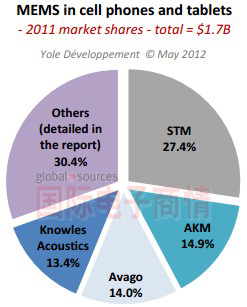關鍵字:移動設備 MEMS
Yole Development的慣性MEMS分析專家Laurent Robin指出:“手機和平板電腦中的MEMS器件市場將以年均20%的速度增長,到2017年營業收入達54億美元。”

十大MEMS應用
MEMS器件在移動設備中極為流行。不過,盡管如此,目前只有如下3類MEMS器件應用廣泛:
1.運動傳感器。包括加速計,磁力計和最近大熱的陀螺儀。這個領域保持高速增長,技術變革也持續不斷。比如,提供更高水平的集成技術和融合算法的組合傳感器。
2. MEMS麥克風:取代傳統ECM及因手機新功能所需的多個麥克風陣列,MEMS麥克風的市場前景非常光明。
3.BAW濾波器和雙工器:很多年前BAW就廣泛應用于Band 2中,未來則會應用在4G的基帶中。

還有很多MEMS應用正在研發中。Yole的報告提出了一些將極大地影響MEMS市場的新機遇:
1.雖然目前在天氣預報中的應用不多,壓力傳感器將被組合到慣性傳感器中以用于提供基于位置的服務(LBS)。
2.RF MEMS在2011年開了個好頭,未來將受益于天線調頻的發展
3.振蕩器則是另一個大熱的市場,硅基MEMS有望取代TCXO石英晶振以及集成諧振器。
4.相比于現有的VCM技術,MEMS自動對焦能提供更高的附加值。不過,不可掉以輕心,因為還有很多其它有競爭力的技術。
5.其它類型的MEMS:微顯示器、微揚聲器、環境傳感器、觸摸屏、游戲桿等。
廠商排名及未來發展
MEMS市場在2009年到2011年間翻了3番,這對每個MEMS制造商而言都是巨大的機會。過去兩年來,領先廠商的排名也發生了變化:2009年到2011年,在手機應用市場, ST從第三升至第一,營收也超過了4.77億美元。而在MEMS加速計領域,ST仍保持其主宰地位。同時,ST也順利打開了MEMS陀螺儀市場,在該領域能威脅其地位的僅有InvenSense。作為一個頂級供應商,ST正努力在其它MEMS市場擴大其影響力以保持競爭力。ST的主要客戶有蘋果、三星、諾基亞、 黑莓和惠普。
其它大型MEMS廠商也都有自己的核心市場:AKM銷售額為2.60億美元,稱雄于電子羅盤磁力計市場;Avago則以2.44億美元的營收稱霸BAW濾波器和雙工器市場;Knowles是MEMS麥克風的領頭羊,營收為2.33億美元。

報告里還指出以下將影響未來競爭格局的趨勢:
1. 許多初創公司將推出的顛覆性技術:包括新型市場的RF MEMS開關和可變電容器、用于微型投影儀的掃描微鏡、硅定時器、揚聲器、自動對焦MEMS等;以及現有市場的mCube慣性傳感器、3S麥克風等。
2. 受此市場的高增長及高利潤空間吸引,大型半導體公司都開始關注MEMS市場:飛兆半導體和Maxim通過收購進入市場,而其它公司也將緊隨其后。
3. 出現新的商業模式:有專攻產業鏈的特定環節的,如MEMS制造、信號處理等;也有提供完整解決方案的,如整合MCU和軟件的組合傳感器。
MEMS產業將深受移動設備的全球性趨勢影響:設備互聯,音像制品消費,社交化網絡,用戶多樣性以及移動廣告等。Yole Développement也指出,某種意義上來說,MEMS傳感器提供的多種功能也反過來促成了市場對智能手機和平板電腦的爆發性需求。
“20% annual growth to reach $5.4B in 2017!,”announced Yole Développement
“MEMS for Cell Phones & Tablets”, a new report from Yole Développement
Lyon, France – May 22, 2012 – Yole Développement announces its report “MEMS for Cell Phones & Tablets”.
“New MEMS devices will benefit from the mobile device growth that is predicted for the coming years: phones and tablet will represent a 2.9B units in 2017 and most of them will integrate 5 to 10 MEMS devices”, announces Laurent Robin, Activity Leader, Inertial MEMS Devices & Technologies, Yole Développement.
10 new MEMS applications to be >$100M in 2017
MEMS devices are extremely popular in mobile applications. Despite this interest, only 3 categories of MEMS devices are in high volume production today:
? Motion sensors: including accelerometers, magnetometers and more recently gyroscopes is the hottest market segment. It is still growing quickly and many business and technical evolutions are expected. One of them is the launch of combo sensors which provide a higher level of integration and possibly embed sensor fusion algorithms
? MEMS microphones : which are promised to a bright future, driven by ECM replacement and by new functionalities that require multiple microphones
? BAW filters and duplexers : BAW is popular since many years for the Band 2 in particular, and new opportunities will appear with some of the bands that will be used in 4G standards
Many other MEMS products are under development. The report highlights that novel MEMS opportunities need to be watched as they will fuel this market significantly:
? While limited to weather forecast applications today, pressure sensors are going to be used
2
in combination with inertial sensors to provide location-based services
? RF MEMS switches had a successful start in 2011 and will benefit from the current hype for antenna tuning
? Oscillators is another hot area where silicon MEMS has a high potential, both for replacing TCXO quartz oscillators and for integration of resonators
? Another hot market is going to be MEMS auto-focus which provides significant added value compared to the existing VCM technology, but will face competition with other technologies as well
? And many other types of MEMS are emerging: microdisplays, microspeakers, environmental sensors, touchscreen, joystick…
Newcomers to join ST and the other leaders in this attractive market
Opportunities are thus huge for MEMS device makers, as this market tripled from 2009 to 2011. The ranking of the top players has also evolved the past 2 years: ST Microelectronics was number 3 in cell phone applications in 2009 and is now the number one supplier by far with $477M cellphone and tablet revenue in 2011. ST Microelectronics still dominates the MEMS accelerometer market, had an impressive start with MEMS gyroscopes, only challenged by InvenSense, and continues to expand to many other MEMS devices to become a one-stop supplier.
ST Microelectronics major clients are Apple, Samsung, Nokia, RIM and HP. Other large players are very focused on their core markets: AKM is the number 2 with $260M sales of magnetometers for electronics compass solution, Avago is leading the BAW filters and duplexers market with $244M sales, and Knowles is number 4 with $233M revenues from MEMS microphones. The trends which are shaping the competitive landscape of tomorrow are analyzed carefully in this report:
? Many start-ups are about to introduce disruptive technologies on the market: both for emerging markets (RF MEMS switches and variable capacitors, scanning mirrors for picoprojectors, silicon timing devices, speakers, auto-focus…) and for the current large markets (MCube for inertial sensors, 3S for microphones…)
? Attracted by this growing and high-margin market space, large semiconductor companies are now eyeing MEMS: Fairchild and Maxim already made the move through acquisitions, and others should follow
? New business models are being developed and it appears that some players specialize on a specific part of the value chain (MEMS manufacturing, signal processing…) while others are offering complete solutions (e.g. combo sensors which integrate MCU and software)
“The market for MEMS in cell phones and tablets will grow 19.8% to reach a $5.4B value in 2017”, says Laurent Robin, Activity Leader Inertial MEMS Devices & Technologies, Yole Développement. The MEMS industry will be largely impacted by global trends in mobile devices: connected devices, video and music consumption, social networking, diversity of users and usages, mobile advertising. In the reverse way, Yole Développement also notes that the booming demand for smartphones and media tablets can be partly explained by the integration of MEMS sensors which provide new functionalities.
 移動設備訪問
移動設備訪問